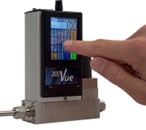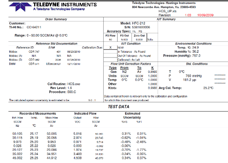 Calibration is the cornerstone of measurement accuracy, ensuring that instruments deliver reliable and precise data. Thermal mass flow meters play a pivotal role in providing a dependable solution for various industries. The calibration of these instruments is a critical factor that demands meticulous attention. In this blog, we delve into the intricacies of thermal mass flow calibration, unraveling the science behind it and its significance in achieving accurate measurements.
Calibration is the cornerstone of measurement accuracy, ensuring that instruments deliver reliable and precise data. Thermal mass flow meters play a pivotal role in providing a dependable solution for various industries. The calibration of these instruments is a critical factor that demands meticulous attention. In this blog, we delve into the intricacies of thermal mass flow calibration, unraveling the science behind it and its significance in achieving accurate measurements.
The Basics: What is Thermal Mass Flow Meter Calibration?
Teledyne Hastings’s flow meters and flow controllers use thermal mass flow sensors. The Teledyne Hastings Instruments 200 Series thermal mass flow meters operate on the principle of heat transfer using thermocouple technology. The flow sensor consists of a capillary tube that is heated at the midpoint. Thermocouples are used to measure the temperature on both the inlet and outlet ends of the tube. As gas molecules travel through the flow sensor, heat is transferred downstream. The temperature differential between inlet and outlet correlates to the molecular flow rate of the gases. The molecular flow rate is directly proportional to the mass flow rate of the fluid. This relationship forms the basis for the calibration process, as accurate calibration ensures that the meter provides reliable measurements across a range of flow rates and conditions.
Calibration is indispensable for maintaining the accuracy and reliability of thermal mass flow meters. Over time, factors such as contamination, sensor degradation, environmental changes, or wear and tear can impact the meter's performance. Calibration allows for the correction of these deviations, ensuring that the meter consistently produces accurate readings. Moreover, many industries are subject to regulatory standards that mandate regular calibration to guarantee the reliability of the data collected.
How To Calibrate Your Mass Flow Meter

- The first step in thermal mass flow calibration is establishing a reference standard. This is typically a device with a known and traceable accuracy. The reference standard is used to compare and verify the accuracy of the mass flow meter being calibrated. This can be a reference standard or another flow meter. A high accuracy 300 Vue thermal mass flow meter or mass flow controller with local touchscreen display would create a standard that the unit under calibration will match to.
- Calibration involves subjecting the flow meter to controlled flow rates covering its entire operating range. The meter's response to these different flow conditions is carefully observed and compared to the reference standard. The best calibration would be used with actual gas to get the most accurate data points. Since the actual gas (e.g. Helium) could be expensive or rare, then a more accessible gas such as N2 or Air is used with a conversion factor to calculate the actual flow rate in the desired gas.
- As the flow meter undergoes calibration, data on its performance at various flow rates is collected. This data is then analyzed to identify any deviations from the reference standard. The reference temperature and pressure may differ from the actual process temperature and pressure. Calibration software may be employed to streamline this process.

- If discrepancies are detected, adjustments are made to the thermal mass flow meter to correct its readings. This may involve recalibrating sensor elements or updating compensation factors. The goal is to align the meter's measurements with the reference standard. It is important to note how large these discrepancies are as it may require repair instead of calibration.
